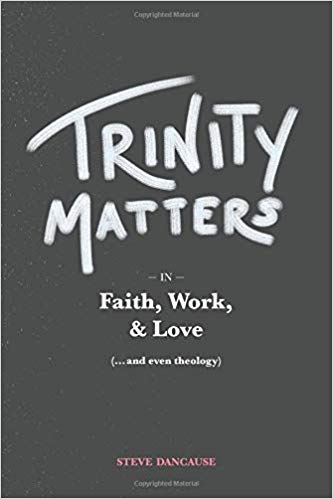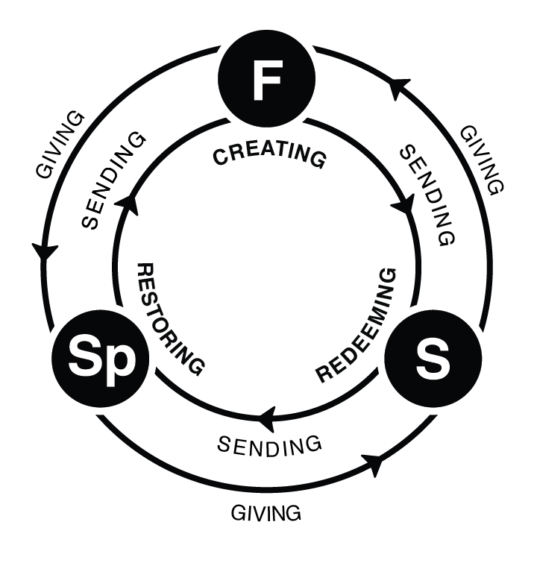What we believe about God informs how we relate to others, to ourselves, and to the world around us. This conviction is part of why integration is at the very heart of our mission, and is even built into our name, The Seattle School of Theology & Psychology. Here, we talk with Steve Dancause (MA in Christian Studies, ‘08) about his new book Trinity Matters: In Faith, Work, and Love, and about how a robust theology of the Trinity might shape how we approach our work and relationships. You can read an excerpt of Steve’s book below this interview.
 Can you tell us a little about yourself and the work you do?
Can you tell us a little about yourself and the work you do?
I’ve been a bi-vocational pastor for 10 years. My wife and I break the mold in that she is the full-time pastor. The work I do, whether it is a non-ministry job, being a stay-at-home dad for a time, or being a pastor, supports her ministry.
What inspired you to write a book about the Trinity?
The Trinity confused me, and I found that nearly all Christians are confused as to who the Trinity is. A lot of churches and even pastors see God as a patriarchal hierarchy, and we justify abusive relationships this way. The truth is that God is an egalitarian community of love.
Why do you think a robust, well-defined view of the Trinity is important?
At the risk of sounding dramatic, I do not believe that Christianity will survive without a robust Trinitarianism. Nor should it. We have absolutely nothing to offer the world except for our God who is love, and who inspires us to love those who are different than us.
All this month on the Intersections blog we’ve been exploring relationships of all forms, grounded in the belief that the enduring need for connection is a core part of how we are created. How do you see the divine relationship informing how we approach relationships with each other?
God is a community of persons, but we often think of God as a lone individual (the Father), and then we think of ourselves as lone individuals. We each bear God’s image, but we better bear God’s image together in community. God exists in and through relationship, and so do we.
What’s your hope for folks who read your book? How do you hope it will add to the ongoing conversation?
Christianity has literally become Godless. We don’t believe that Jesus and the Spirit are really God, so we don’t follow Jesus’s commands to love, and we don’t believe that the Spirit can transform us into people who give and receive love better. By embracing the Trinity, I hope that we can all rediscover our God who is interpersonal love, and who is present within, beyond, and between us.
Eternity
Imagine a God who exists eternally as a community of three equally divine persons. The relational communion of the three is so perfect that they are one divine being. And this one relational God is love. This love is dynamic—open to the other, to giving and receiving. Each divine person exists in and through this love. Each pours their self out sacrificially on behalf of the other two, even as they are filled by the other two. The one constitutes the three, while the three constitutes the one. This is the eternal dance of love.
Creation
Now imagine that God chooses to extend this love beyond Godself, to overflow it into something new. So God creates the universe. In an act of self-limitation and sacrifice, God pulls back to make room for something other than God. The Spirit takes the lead in the eternal dance and hovers over the primordial “waters” of this void. The Spirit then pours himself out into the Father and the Son, overflowing the eternal dance of love into creation. Through this self-emptying, the Spirit sends the Father as Creator and gives divine power over our creation to the Son, through whom all things are created. And it was good.
Then God said, “Let us make humankind in our image, according to our likeness” (Gen. 1:26, emphasis mine). Male and female, individuals created in the image of the one God, yet together created in the image of the communal God who exists through interpersonal relationships. And it was very good. Yet there were bound to be problems for a Creator who is love, for love requires persons who are free to accept or to reject their part in the dance, persons who are free to choose for or against relationship. And so the relational barrier of sin and death infects and separates humanity from God. Yet from eternity the Trinity had chosen a solution to our problem. A solution with a great cost.
Redemption
Imagine that the Father takes the lead in the eternal dance. Reciprocating the work of the Spirit, he pours himself out into the Son and Spirit, the dance of love overflowing. In self-emptying, the Father sends the Son as Redeemer and gives divine power over our redemption to the Spirit. The Son temporarily gives up his divine privileges and becomes fully human. God submits to becoming a part of creation, yet God cannot stop being God. He takes on our fallen humanity—a humanity that can sin like us—but through obedience to the Father and submission to the Spirit, Jesus does not sin like us, making a way for us. In Jesus, God is perfectly represented for us, and the character of God is fully seen in submitted, self-giving, Spirit-empowered life.
God makes space within eternity for humanity, for God and humanity exist perfectly and paradoxically together in the person of Jesus Christ. Now watch how sin and its curse—our suffering, alienation, even death itself—is taken upon Jesus on the cross, causing him to experience a loss of communion with the Father and the Spirit. He feels abandoned. “Why have you forsaken me!” he cries, echoing the lament of Psalm 22. Yet Jesus does not reject his humanity—he knows the Psalm ends in the good and perfect peace between God and us. The Spirit empowers him to be faithful to the end.
God pours Godself out for us, and takes on the consequences of sin and death. As Jesus speaks his last words, he commends his Spirit into the arms of God. And then he takes his last, dying breath. The dance seems to end abruptly. It is hard to imagine. Yet the Father and Spirit do not let go of their beloved, for the being of God cannot be broken. What is the Trinity to do when Jesus dies? What they always do, and had purposed to do all along—they dance. God makes space for humanity as Jesus extends the dance straight through sin, suffering, and death.
Jesus never lets humanity go, and Father and Spirit never let Jesus go. Jesus is one with us and one with Father and Spirit. Thus God holds onto us through death itself. The Trinity reaches through the very core of darkness, and there Jesus falls in complete trust into the embrace of Father and Spirit. And the Trinity dances, this time on both sides of the relational barrier, and this dance shatters sin and death, raising Jesus from the dead. And so begins the good and perfect peace of a new creation.
Restoration
Imagine now that the risen Son reciprocates, taking the lead in the eternal dance. All authority in heaven and earth has been given to him, so he pours himself out into the Spirit and the Father, the dance of love overflowing. In doing so he sends the Spirit as our Restorer, who is actively preparing the world for Jesus’ return. Jesus waits for the time when all things will be reconciled to God, when he will give all things back to the Father. And the Father, who knows the day of final restoration, works, and waits, and loves.
The powers of evil and death have suffered a mortal blow. We can live through our own suffering and death knowing that like Christ’s, it will end in total victory and reunion with our beloved God. Soon the day will come when time and space will be folded into eternity. For those who say yes to God, the dance draws us in. For in Jesus—who holds both divine and human, eternal and temporal, heaven and earth, perfectly and paradoxically together—the dance has been extended to you and to me. Jesus reaches out his hand and asks you to follow him, desiring you to join this eternal movement of love, or what he simply calls “eternal life.”



